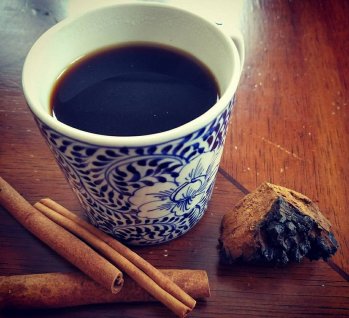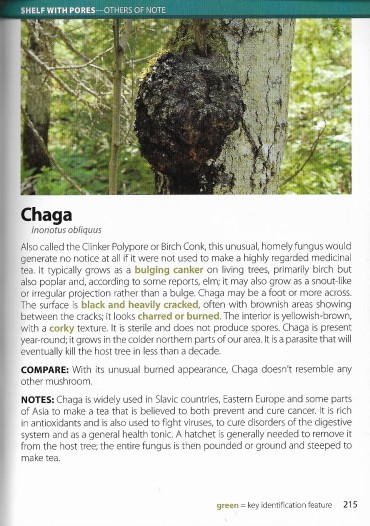Overview
For those of you who don’t know, Chaga refers to a medicinal fungus (Inonotus obliquus) occurring on Birch (Betula) species of tree in the northern hemisphere, most commonly in the boreal forests of Russia and Siberia, Eastern Europe and Northern North America. In Wisconsin, it most commonly occurs in the northern half of the state, stretching up into the U.P, Minnesota and Canada.
Chaga is most commonly consumed as a beverage. Chaga “tea” is a decoction of Chaga chunks or ground chaga, boiled and simmered for at least 45 minutes. This is said to help boost immune function due to it’s polysaccharide and antioxidant content, and has been drunk in Russia and Eastern Europe traditionally for this purpose. It’s also a very pleasant tasting drink, not mushroomy at all, it has woody hints and an almost vanilla like tone to it.
Chaga Tea

Medicinally, to combat symptomatic illness, you most commonly see Chaga administered or taken as a double extracted tincture. This is where the alcohol soluble compounds are extracted first, then the same material undergoes a water extraction, and the two are blended together. This allows you to get both the alcohol and water soluble compounds both of which are said to hold medicinal properties.
Chaga double extract from Megan’s Herbal Apothecary.

I shall be discussing more information on the uses of Chaga, along with harvesting techniques in another post, for now lets focus on how to recognize it.
My experience
I have been harvesting and using Chaga for years now, and started researching it even before that. I began by extensively hiking the Scottish Highlands, in the UK to find Chaga, the only area In the British Isles where Chaga is endemic. I have probably found a few thousand pieces of Chaga there. Since I have been foraging in Wisconsin and Michigan I have also found it extensively on several species of birch. I am often tagged in online to confirm or deny Chaga identification posts because of my experience with harvesting it and differentiating from it’s look-alikes.

Identification
The focus of this post is on Chaga identification. It is so commonly misidentified that is has become a bit of a joke in the mycological community, spawning many “is this Chaga” type memes, such as the below.
Chaga meme

The “Chaga” we are looking for is a mycelial mass known as a Sclerotia, which emerges from the heartwood of birch trees, pushing its way out through the bark. It’s external surface is dark black and burnt looking, with a crusty appearance, the inside is a two tone orange pattern as seen in photo 2 below.
With Chaga being confined to birch forests in the north, or at altitude (e.g. in Tennessee), and with it being less than abundant in many areas, there are many cases of people misidentifying other things as Chaga. It’s often very much a case of wishful thinking. I will go through some of these below.
The Brackets
There are many species of bracket fungus out there, and several other common ones which you will encounter more frequently on birch than you will Chaga.
Most commonly I see the Fomes fomentarius (Horse hoof fungus) bracket mistaken for chaga, along with others in the Phellinus, Fomitopsis and Ganoderma genus.
Below are two examples of someone who is purporting to be a professional, advertising Chaga, when in fact the photo is another type of bracket, you can see the pore surface underneath, which is absent in the Chaga Sclerotia.
NOT CHAGA!
The Burls
This is where the most common confusion occurs. Burls are actually just part of the tree. They are malformed wood growths causes by insects, viruses, fungal pathogens, or stress. The confusion comes because many burls have a dark and round form protruding from the trunk, as does Chaga. I regularly see fairly experience foragers make this mistake, as Chaga is not something many people have experience in.
Chaga vs Birch Burl
As you can see with the Chaga on the left, the outer surface is very black almost like charcoal, with pieces of the surface easy to break off. If you take a piece of white clothing, wet it and rub it against Chaga it will stain badly. The Chaga growth will often have pieces of bark adhering to it due to the way it growth out from the heart wood of the tree and emerges from the bark.
Sometimes you will see burls that are wider than the width of the tree that people think are Chaga, due to the way Chaga grows, it will not be wider than the width of the trunk, so that’s a good way to differentiate in these cases.
Below is an illustration that even “experts” can get it wrong. This is a scan from the book ‘Mushrooms of the Upper Midwest’ by Teresa Marrone and Kathy Yerich, a pocket guide I’ve seen recommended by many to those foraging in the Midwest.
NOT CHAGA!

What we see above is actually a burl, and not even a birch tree, Chaga grows almost exclusively on birch. Inonotus Obliquus rare occurs on non Betula species, but it generally isn’t termed ‘Chaga’ as Chaga refers to the fungus on birch, for its particular medicinal qualities.
This really does compound the problem of poor identification when the guidebooks don’t always get it right, and ends up causing people to try and cut into burls, damaging trees for no purpose.
Summary
I hope now you all have a better idea as to what Chaga is, and how to tell it apart from potential look alikes, I will be posting more on Chaga throughout the winter, including some info on how to harvest and use it, but feel free to comment or message me with any questions you might have in the meantime. When exploring the world of Chaga please do take care to get accurate identification, and don’t try and harvest things speculatively. When harvesting Chaga always think about what is sustainable, I will discuss my thoughts on this later.
Finally, below I have added a small slideshow gallery of Chaga photos, to help you recognize it even further.
Signup for Updates
click the link below to sign up for mailing list alerts.
For more foraging related content follow Matt’s foraging adventures on social media
- matt@edenwildfood.com
- www.edenwildfood.com
- Twitter: @edenwildfood
- Facebook: www.facebook.com/edenwildfood
- Instagram: https://www.instagram.com/eden_wild_food/
- Midwest foragers join FB group Wild Food Wisconsin
Copyright Matthew Normansell 2017 All rights reserved.






very informative
LikeLiked by 2 people
Thanks Dave. More to come over the winter on usage and harvesting.
LikeLike
Thank you for this- wonderfully illustrated. i’m nowhere near, so I doubt i’ll be coming across Chaga soon. Curious though, are the birch trees dead or dying due to the fungus? I find ganoderma Tsugae on dead hemlocks in NC, so that’s why I ask.
LikeLike
Ganoderma Tsugae are saprobic, ie eating dead wood, so you will find them on dead trees and logs. Chaga is parasitic so infects, and grows on living trees and will eventually kill the tree, but unlike armillaria etc its a fairly weak parasite so trees will live many years with chaga infection. It also persists for a time once the tree has died before dying itself and breaking down
LikeLike
Thank you Mathew! Looks like I need to go further north in Wisconsin if I’m ever going to find it! Looking forward to your future posts. 🙂
LikeLike
Yes it does seem to be confined to the North here.
LikeLike
Have you ever looked for it in the Machikanee forest?
LikeLike
No I’ve not looked there. I dont recall if I’ve visited that forest or not I’ve definitely passed by it though. I believe it’s largely replanted jack pine so its less than ideal habitat for chaga but there may be birch around and its always a possibility
LikeLike
I’m adding your blog to my Feedly. Looking forward to seeing and reading more from you.
LikeLike
Thanks Cindy
LikeLike
Is Chaga seasonal?
LikeLike
If you read my new blog post on harvesting I cover this https://edenwildfood.wordpress.com/2017/12/18/harvesting-chaga-what-you-need-to-know/
But no chaga persists slowly growing for years but generally is recommended to harvest in the winter 🙂
LikeLike